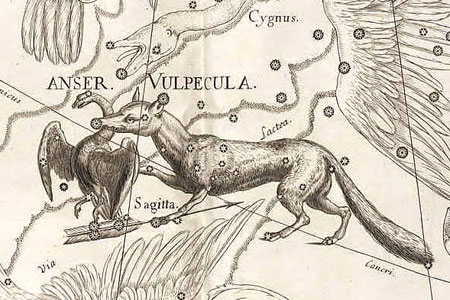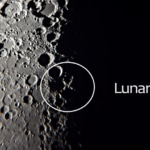Little Fox In The Sky
This summer while star gazing look for the little fox in the sky. Here's how and why.

For those who know their constellations, the night sky is a menagerie of beasts both realistic and mythic.
Vulpecula, which is Latin for “the little fox,” is one such celestial animal. The constellation was introduced in the 17th century by Polish astronomer Johannes Hevelius, who took it upon himself to catalogue those corners of the sky the ancient Greeks had failed to leave their mark on.
Vulpecula is one of the lesser-known constellations, probably because it’s small and relatively dim. It is one of 88 official modern constellations, and one of 40 that is not of ancient origin. Hevelius originally named the constellation “Vulpecula cum ansere,” or “the little fox with the goose.” Illustrations of the constellation most often depicted a fox with a goose dangling from its mouth.
The fox sits in the southern sky bordered by Cygnus, Lyra, Hercules, Sagitta, Delphinus, and Pegasus.
Alpha Vulpeculae, a red giant that sits approximately of 297 light-years from Earth, is the brightest star in the constellation. It sits at the mouth of the fox, and was traditionally known as Anser, the goose. The star’s brightness is actually augmented by another unnamed star that lines up with it from our perspective on Earth, though it is actually nowhere near Asner. This phenomenon, when chance alignment causes two distant stars to appear as a double star system, is called an “optical binary.”
Though it isn’t much to look at, Vulpecula is notable because it contains the first pulsar ever discovered.
A pulsar is a rotating star that is only visible from one angle. These stars blink in and out of view as they turn, similar to the beam of a lighthouse. Antony Hewish and Jocelyn Bell discovered the pulsar, which bears the creative name PSR B1919+21, in 1967. Later, another pulsar, PSR B1937+21 was found in the constellation. This second pulsar was the first millisecond pulsar ever discovered, meaning that it spins several times per second. In fact, it is the fastest pulsar ever discovered, rotating at a rate of roughly 641 times a second.
The constellation is also home to one of the closest extrasolar planets currently being studied by the Spitzer Space Telescope, as well as two deep sky objects: the Dumbbell Nebula and the spiral galaxy NGC 7052.
The Dumbbell Nebula, also known as M27, is a Messier object, one of the bright deep sky formations first identified primarily by French astronomer Charles Messier during the 18th Century. It got its name from its distinctive double-lobed shape, similar to an hourglass or a hand weight.
Because it is a modern constellation, Vulpecula has no role in classical mythology, though there is folklore surrounding the animal. Foxes have long been associated with deception and cunning, and there is a widespread belief in many cultures that foxes are shape-shifters and can take human form. Similarly, the ancient Greeks believed that Dionysis, god of wine and revelry, often took the form of a fox when he visited the world of mortals.
While not much compares to the sleek beauty of a real fox, be sure to take some time this summer to check out the “fox” in the night sky.

Jaime McLeod
Jaime McLeod is a longtime journalist who has written for a wide variety of newspapers, magazines, and websites, including MTV.com. She enjoys the outdoors, growing and eating organic food, and is interested in all aspects of natural wellness.






I, too, have always been fascinated by all the constellations and planets. Although I am not educated as to the names and when they are most prevalent I love looking at them and am in awe as to the vastness in the sky. Last night was a good night to view the sky. Thank you for your information.
You hit it out of the park yet again, Jaime. Thanks for another deep one.
My parents moved my sister and I to the country when I was about five, we could see the stars at night like looking at a beautiful black tapestry with billions of shining lights. But what really got me fascinated was when I was about 10 or 11years old my cousin John who was in college would sit outside at night when we visited my aunt and show me the different stars with his telescope and tell me all about each of them while I didn’t understand much of what he said it got me into science fiction star trek and every other space movie so now years later when I go outside at night and look at the stars it always reminds me of sitting on the back porch of their house with my cousin looking at the stars and I will always be grateful to him for opening up my mind to the vastness of space with all its mysteries, Thank you, John